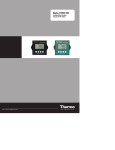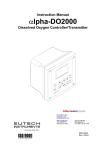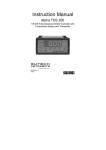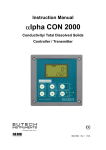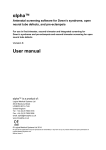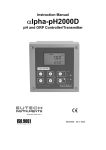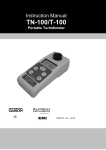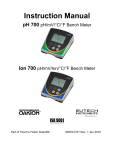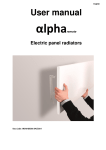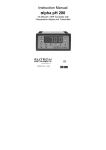Download Instruction Manual
Transcript
Instruction Manual αlpha-CON550 Conductivity Monitor mS/µS/ºC/ºF meter Technology Made Easy ... 68X216870 Rev 3 Aug 07 Preface This manual serves to explain the use of the αlpha-CON 550 Industrial Conductivity Monitor. The manual functions in two ways, firstly as a step by step guide to help the user operate the instrument. Secondly, it serves as a handy reference guide. This instruction manual is written to cover many anticipated applications of the αlpha-CON 550 monitor. If you have doubts in the use of the instrument, please do not hesitate to contact the nearest Eutech Instruments Authorised Distributor. The information presented in this manual is subject to change without notice as improvements are made, and does not represent a commitment on part of Eutech Instruments. Eutech Instruments cannot accept any responsibility for damage or malfunction of the unit due to improper use of the instrument. Copyright ©2006 All rights reserved. Eutech Instruments Pte Ltd. Table of Contents 1. Introduction ...........................................................................................................1 1.1 1.2 1.3 1.4 Before You Begin ................................................................................................................... 1 Intended Use .......................................................................................................................... 1 Safety Instructions.................................................................................................................. 2 Taking Out of Service / Correct Disposal of the Unit ............................................................. 2 2. Getting Started ......................................................................................................3 2.1 2.2 2.3 2.4 2.5 Description of Instrument ....................................................................................................... 3 Measurement System ............................................................................................................ 4 Connecting Peripherals.......................................................................................................... 5 2.3.1 Connection Terminals.................................................................................................... 5 2.3.2 Switching Between Pt100 & Pt1000 Temperature Sensors.......................................... 6 2.3.3 Connecting Conductivity Probe ..................................................................................... 7 2.3.4 Connecting Temperature Probe .................................................................................... 7 Installation .............................................................................................................................. 8 2.4.1 Mechanical Dimensions................................................................................................. 8 2.4.2 Wall Mount..................................................................................................................... 8 2.4.3 Panel Mount................................................................................................................... 9 Display & Keypad ................................................................................................................. 10 2.5.1 Display Overview......................................................................................................... 10 2.5.2 Key Functions .............................................................................................................. 11 3. Operation .............................................................................................................12 3.1 3.2 Measurement mode ............................................................................................................. 12 Menu Overview .................................................................................................................... 13 4. Calibration Mode .................................................................................................14 4.1 4.2 About Calibration.................................................................................................................. 14 Calibration ............................................................................................................................ 15 5. Setup Mode ..........................................................................................................17 5.1 5.2 5.3 5.4 5.5 5.6 Enter Setup mode ................................................................................................................ 17 Temperature Coefficient Settings......................................................................................... 18 Temperature Settings........................................................................................................... 19 Measuring Range Settings................................................................................................... 21 Configuration Settings .......................................................................................................... 22 Viewing Electrode Properties ............................................................................................... 24 6. Technical Specifications.....................................................................................25 7. List of Accessories .............................................................................................27 8. Troubleshooting ..................................................................................................28 9. General Information ............................................................................................29 9.1 9.2 9.3 Warranty............................................................................................................................... 29 Return of Goods ................................................................................................................... 29 Guidelines for Returning Unit for Repair .............................................................................. 29 10. Appendices .......................................................................................................30 10.1 Appendix 2 Conductivity of various aqueous solutions....................................................... 30 10.2 Appendix 4 - Abbreviations Used in LCD............................................................................. 31 αlpha-CON 550 Instruction Manual 1. Introduction 1.1 Before You Begin We thank you for purchasing the αlpha CON 550 monitor. The construction of the CON 550 monitor employs leading edge technology and complies with safety regulations currently in force. Notwithstanding this, improper use could lead to hazards for the user or a third-party, and/or adverse effects on the plant or other equipment. Therefore, the operating instructions must be read and understood by the persons involved before working with the monitor. The instruction manual must always be stored close at hand, in a place accessible to all people working with the conductivity monitor. If you have questions, which are not or insufficiently answered in this instruction manual, please contact your authorized supplier. They will be glad to assist you. 1.2 Intended Use αlpha CON 550 monitors are intended solely for conductivity and temperature measurement, as described in this instruction manual. Any other use, or use not mentioned here, that is incompatible with the technical specifications is deemed inappropriate. The operator is solely responsible for any damage arising from such use. Other prerequisites for appropriate use include: – Comply with the instructions, notes and requirements set out in this instruction manual. – Comply with all local safety regulations concerning safety at work. – Comply with all information and warnings in the documentation dealing with the products used together with the conductivity monitor (housings, sensors, etc.). – Comply with local environmental and operational conditions. 1 αlpha-CON 550 Instruction Manual 1.3 Safety Instructions - The αlpha CON 550 monitor should be installed and operated only by personnel familiar with the instrument and who are qualified for such work. - A defective CON monitor must neither be installed nor put into service. - The αlpha CON 550 must only be operated under the specified operating conditions (see section 6). - The αlpha CON 550 must not be repaired by the customer. - No modifications to the αlpha CON 550 are allowed. The manufacturer/supplier accepts no responsibility for damage caused by unauthorized modifications. The risk is borne entirely by the user. 1.4 Taking Out of Service / Correct Disposal of the Unit Taking out of Service • First disconnect the unit from the power supply and then undo all electrical connections. • Remove the unit from the wall / panel. Correct Disposal of the Instrument When the αlpha CON 550 monitor is permanently taken out of service, obey the local environmental regulations for correct disposal or send the instrument to your local distributor, they will take care of proper disposal. 2 αlpha-CON 550 Instruction Manual 2. Getting Started 2.1 Description of Instrument The Eutech Instruments’ αlpha CON 550 monitor is used for measuring conductivity and temperature values. The monitor can be used for applications such as water treatment and controlling, galvanicdecontamination, chemical processing, food processing, clean or wastewater control and neutralization processes. The monitor has many user-friendly and safety features which include: • Push-button keypad for calibration and setup • Built-in non-volatile memory to ensure that calibration and other information are not erased if power supply fails • Menu-driven program that simplifies setup • Automatic temperature compensation (ATC) • Manual temperature compensation setting without the ATC probe, with independent setting for calibration and process temperature • Large dual display LCD for easy reading with clear multiple annunciators, operational mode indicators and error indicators 3 αlpha-CON 550 Instruction Manual 2.2 Measurement System A typical measurement system consists of: • A conductivity process monitor • A conductivity sensor with integrated or separate Pt100/Pt1000 temperature sensor • An appropriate measurement cable • An immersion, flow or process assembly Alpha CON 550 Monitor lpha pH560 ESC CAL ENT pH Monitor Housing and Sensors Measurement Cable 4 Power Adaptor (+9 V DC) αlpha-CON 550 Instruction Manual 2.3 Connecting Peripherals 2.3.1 Connection Terminals Remove Back Cover: Remove the screws from the four corners at the back of the conductivity monitor. Remove the back cover. The connectors are exposed on the back PCBA as shown in the Figure 1 below. Connectors: • J8 – 9V DC power connector (1.2mm diameter) • J9 – Relay connections • J10 - Conductivity electrode & Temperature probe connections (wiring has to be done in the detachable connector J8 J10 Connections 1. CON Low Current 2. CON Low Voltage 3. CON High Voltage 4. CON High Current 5. Pt 100 Compensate 6. Pt 100 Sense 7. Pt 100 GND 8. (No connection) 9V DC Power Screw J10 Figure 1: Outer Side of Back PCBA 5 αlpha-CON 550 Instruction Manual 2.3.2 Switching Between Pt100 & Pt1000 Temperature Sensors The conductivity monitor supports both Pt100 & Pt1000 (2-wire or 3-wire) temperature sensors. The default factory setting is Pt100. If you need to use Pt1000 temperature sensor, you have to change the jumper setting (J7) as described below. Remove Back Cover: Remove screws from the four corners at the back of the conductivity monitor. Remove the back cover. Remove Back PCBA: Remove the screw located center of the back PCBA (Figure 1). Detach the back PCBA from the monitor. Turn over the back PCBA. Locate J7 jumper on the inner side of the back PCBA as shown in Figure 2 below. J7 Jumper Setting for Pt100 (Factory Default) Jumper Settings for Pt1000 Figure 2: Inner Side of Back PCBA Set Jumper J7: Set the J7 jumper to required sensor (Pt100 or Pt1000) type. 6 αlpha-CON 550 Instruction Manual 2.3.3 Connecting Conductivity Probe Any industrial conductivity probe (2-cell or 4-cell) can be connected to the conductivity monitor. 2-Cell Conductivity Probe: 1. Short Pin 1 & 2 of J10 connector using a jumper wire. 2. Connect CON low input wire (white) to Pin 2 of J10 connector. 3. Connect CON high input wire (black) to Pin 3 of J10 connector. 4. Short Pin 3 & 4 of J10 connector using a jumper wire. 4-Cell Conductivity Probe: 1. Connect CON low input wire (black) to Pin 1 of J10 connector 2. Connect CON low input wire (white) to Pin 2 of J10 connector. 3. Connect CON high input wire (orange) to Pin 3 of J10 connector. 4. Connect CON high input wire (blue) to Pin 4 of J10 connector. 2.3.4 Connecting Temperature Probe For Automatic Temperature Compensated (ATC) conductivity readings, an in-built temperature sensor is usually integrated with industrial conductivity probes. Alternatively, a separate 100Ω Pt RTD temperature probe (2-wire or 3-wire) can be connected to the monitor. 3-Wire Probe: 1. Connect PT100 compensate wire to Pin 5 of J10 connector. 2. Connect PT100 sense wire to Pin 6 of J10 connector. 3. Connect PT100 GND wire to Pin 7 of J10 connector. 2-Wire Probe: 1. Short Pin 5 & 6 of J10 connector using a jumper wire. 2. Connect PT100 sense wire to Pin 6 of J10 connector 3. Connect PT100 GND wire to Pin 7 of J10 connector. 7 αlpha-CON 550 Instruction Manual 2.4 Installation 2.4.1 Mechanical Dimensions lpha CON550 ESC CAL ENT Conductivity Monitor 2.4.2 Wall Mount 1 2 Pierce through holes at both sides Cover the catch slots at both sides with overlays 8 αlpha-CON 550 Instruction Manual 2.4.3 Panel Mount 1 Prepare panel cut-out of 92.0 mm X 92.0 mm 2 Remove back cover of conductivity monitor and slide it through panel cut-out Gasket Panel Panel 4 Insert threaded rods through catch until conductivity monitor is held against panel 3 Attach catch to both sides of conductivity monitor 9 αlpha-CON 550 Instruction Manual 2.5 Display & Keypad 2.5.1 Display Overview The Liquid Crystal Display (LCD) of αlpha CON 550 conductivity monitor has two alpha-numerical displays (Upper and a Lower). • Upper display: Measured conductivity value is displayed when the monitor is in normal operation (measurement) mode. • Lower display: Measured temperature value is displayed when the monitor is in normal operation (measurement) mode. In conductivity calibration mode, measured conductivity values are displayed here. The two displays indicate function names, options & settings in Setup mode. Refer ‘Appendix 4 - Abbreviations Used in LCD’ for more details. The LCD also consists of various mode indicators, status annunciators and unit of measurement indicators. Upper Display SETUP MEAS CAL -8.8.8.8 READY HOLD ERR R. % mS µS K= - .8.8.8 °C °F ATC Lower Display Mode Indicators MEAS Measurement mode (Refer Section 3.1 ) SETUP Setup mode (Refer Section 5) CAL Calibration mode (Refer Section 4) Status Annunciators READY Appears when the reading is stable HOLD Appears in Setup mode and Calibration mode to indicate that the relay function is frozen ATC Appears when Automatic Temperature Compensation (ATC) is enabled. Not visible when Manual Temperature Compensation (MTC) is enabled. Flashes if the temperature probe is faulty in its ATC mode. (Refer Section 5.3) ERR Appears when an error occurs Electrode annunciator. Blinks during calibration error (Refer Section 4.2) Buffer annunciator. Appears in calibration mode (Refer Section 4.2) K Cell Constant (Refer Section 4.2) 10 αlpha-CON 550 Instruction Manual Units of Measurement Indicators mS Conductivity in Milli Siemens µS Conductivity in Micro Siemens R. Line Resistance in Ohms (Refer Section 5.5) % Temperature Coefficient (Refer Section 5.2) ºC Temperature in Celsius (Refer Section 5.3) ºF Temperature in Fahrenheit (Refer Section 5.3) 2.5.2 Key Functions lpha CON550 ESC CAL ENT Conductivity Monitor Key CAL Description Enter Calibration mode Enter Setup mode ENT Access sub screens (parameters) within a group of settings in Setup mode Confirm (save) setup parameters and numerical values Start/Confirm calibration in Calibration mode. Select a group of settings in Setup mode. Select parameters and increment/decrement numerical values in Setup and Calibration modes. (When pressed continuously, speed of value increment/decrement increases) Returns to Measurement mode when both keys are pressed simultaneously. 11 αlpha-CON 550 Instruction Manual 3. Operation 3.1 Measurement mode When the conductivity monitor is powered on, the display shows all the LCD segments briefly, and then automatically enters into the measurement mode. MEAS µS READY 25.0 °C ATC The mode indicator ‘MEAS’ at the top of the display indicates that the conductivity monitor is in measurement mode. The upper alpha-numerical display shows the measured conductivity value, while the lower display shows the temperature value. The monitor has five selectable measuring ranges. The unit of measurement and resolution of the conductivity reading depend on the selected measuring range. If the monitor reads a conductivity reading beyond the selected measuring range, the display shows ‘Or’ (over range) error indicator. NOTE: To guarantee accurate readings, the measuring system (the conductivity monitor and the sensor) must be calibrated regularly. From measurement mode you can access: • Calibration mode (by pressing CAL key) • Setup mode (by pressing ENT key) For more details, refer section 4 for Calibration mode and section 5 for Setup mode.) 12 αlpha-CON 550 Instruction Manual 3.2 Menu Overview MEAS µS READY CAL ENT °C ATC ENT SETUP ENT ENT ENT ENT ENT ENT ENT ENT ENT ENT HOLD SETUP HOLD SETUP HOLD SETUP HOLD SETUP HOLD 13 αlpha-CON 550 Instruction Manual 4. Calibration Mode 4.1 About Calibration Calibration should be carried out each time a new electrode is attached to the monitor or when you suspect that the monitor/electrode is out of calibration. The monitor allows you to perform temperature calibration and conductivity calibration. About Temperature Calibration It is important to ensure that temperature calibration is carried out prior to conductivity calibration since temperature readings affect the accuracy of conductivity measurements. It is recommended that temperature calibration should be carried out only if the temperature value displayed on the monitor is different from that of a calibrated thermometer. A temperature offset calibration of ± 10 °C/± 18 °F from the default reading is allowed. Once a temperature calibration is performed, conductivity calibration should be carried out to ensure the accuracy of conductivity measurements. About Measuring Ranges & Conductivity Calibration The monitor has five selectable conductivity measuring ranges. You can only calibrate one-point in the measuring range that you have selected for your process application. You have to recalibrate the monitor every time you change the measuring range since the calibration data of the monitor will be reset every time a new measuring range is selected. About Conductivity Calibration During conductivity calibration, the monitor allows a calibration window of ± 40% from the measured default reading of the calibration standard. The minimum allowable calibration point is 10% of the full scale reading of the measuring range selected. For best results, select a standard conductivity solution close to the sample value you are measuring. 14 αlpha-CON 550 Instruction Manual 4.2 Calibration The monitor requires one-point calibration. Conductivity calibration is always carried out in the specific measuring range selected for the monitor. Make sure, the monitor is set to desired measuring range before you enter calibration mode (Refer Section 5.4 for selecting measuring ranges). Select a suitable standard conductivity solution so that its conductivity value is within 10% to 100% of the full scale of the selected measuring range of the monitor. (For better accuracy, select the calibration standard to be nearly 50% of the full scale of the measuring range selected.) Prepare calibration standard solution in two beakers – one for rinsing and the other for calibration. Prepare separate de-ionized water for electrode rinsing. All new calibration values will automatically override existing calibration data. If you wish to abort the calibration, press ▲ and ▼ keys simultaneously and the monitor reverts to measurement mode and the monitor will revert to previous calibration data. 2 1 MEAS 2 ENT HOLD CAL CAL CAL HOLD K= °C 4 3 CAL µS READY µS READY HOLD READY HOLD ATC OR ENT CAL HOLD 3 2 HOLD K= MEAS CAL READY HOLD READY µS ENT µS °C ATC 1 From measurement mode press CAL key to enter calibration mode. 2 The display briefly shows the cell type (“2 CELL” or “4 CELL”) to which the monitor is configured (Refer section 5.5 for cell type settings) Next, the last configured cell constant (k) is displayed in the upper display. Use ▲ or ▼ keys to adjust the cell constant to mach the cell constant of the conductivity probe. Adjustable range is 0.10 to 10.0. Press ENT key to confirm the new cell constant value. Rinse the electrode in de-ionized water and then rinse with the calibration standard. Immerse the probe in calibration standard solution intended for calibration and swirl gently to create a homogenous sample. Make sure there are no any air-bubbles trapped in the sensor. 3 The upper display shows the currently measured conductivity value of the solution based on last calibration (if any). The lower display shows uncalibrated (default) reading of the solution. The buffer annunciator appears in LCD. The ‘READY’ annunciator appears when the reading is stable. Once the reading stabilizes press the ▲ or ▼ key to adjust the upper display value to that of the standard solution. Press the ENT key to accept the value. 15 αlpha-CON 550 Instruction Manual NOTES: • The acceptable calibration window is ±40% of the displayed (default) value. For example, if the display is 1000 µS, the values to which it can be adjusted is 600 to 1400 µS. • If the conductivity reading of the solution is not within 10% to 100% of the full scale of the selected measuring range, calibration error occurs; LCD displays “ERR” and flash electrode annunciator. • If the conductivity reading of the solution is beyond the selected measuring range, calibration error occurs; LCD displays “Or” (over range), “ERR” and flashes electrode annunciator. • If calibration error occurs, exit form calibration mode by pressing ▲ and ▼ keys simultaneously. Calibration is completed. The display shows the calibration factor (FCt). This serves as an indication of the effectiveness of the sensor which will degrade with time and usage. An effective sensor should have a calibration factor of 0.60 to 1.40 4 Press ENT key to return to measurement mode. NOTES: • If you use a 2-cell conductivity sensor, make sure that the pin 1 and 2 are shorted and pin 3 and 4 are shorted on the J10 connector. (Refer section 2.3.3 for more details) • When calibrating with manual temperature compensation, the monitor automatically changes from the preset process temperature to the calibration temperature. After leaving the Calibration mode, the monitor switches back to the process temperature (for setting the calibration temperature and the process temperature, see section 5.3) WARNING: If you change the measuring range of the monitor after calibration is done, the monitor will reset back to its factory default calibration. 16 αlpha-CON 550 Instruction Manual 5. Setup Mode 5.1 Enter Setup mode The setup mode allows you to customize the settings of the conductivity monitor to suite your requirements. While in measurement mode, press the ENT key to access setup mode. LCD shows ‘SETUP’ mode indicator and the first page of setup (rAng – Range settings). Press ▲ or ▼ key to access other pages of the setup mode. MEAS µS READY °C ATC ENT SETUP ENT ENT ENT ENT ENT ENT ENT ENT ENT ENT HOLD SETUP HOLD SETUP HOLD SETUP HOLD SETUP HOLD NOTES: • To exit setup mode at any time press ▲ and ▼ keys simultaneously (escape). The monitor returns to the measurement mode • If you do not press any key for 2.5 minutes, the monitor automatically exists from the setup mode. 17 αlpha-CON 550 Instruction Manual 5.2 Temperature Coefficient Settings Setting the temperature coefficient to match your process/calibration liquids allows monitor to achieve conductivity readings with higher accuracy. 1 SETUP ENT HOLD SETUP SETUP ENT % HOLD HOLD SETUP 4 3 2 SETUP ENT % ENT HOLD 2 ENT HOLD 1 From measurement mode press ENT key to enter setup mode as described in section 5.1. The LCD shows the first screen of setup mode (rAng). Press ▲ or ▼ key to select temperature coefficient settings screen (tC). Press ENT key to access temperature coefficient settings (tC). 2 Select type of temperature coefficient: The upper display shows the last configured temperature coefficient type (Lin or PUr). Press ▲ or ▼ key to select the desired type based on type of your process liquid. PUr : Pure water temperature coefficient: Select this if your process liquid is pure water or ultra pure water. Lin : Linear temperature coefficient: Select this for all other process liquids Press ENT key to confirm your selection. If PUr was selected: The monitor reverts back to tC screen If Lin was selected: 3 Select temperature coefficient for process liquid: The lower display shows ‘P.tC’. The upper display shows last configured temperature coefficient for process liquid (if any). The default value is 2.1%. Press ▲ or ▼ key to select the desired value. Allowable range: 0 to 10%. Press ENT key to confirm your value. 4 Select temperature coefficient for calibration liquid: The lower display shows ‘C.tC’. The upper display shows last configured temperature coefficient for calibration liquid (if any). The default value is 2.1%. Press ▲ or ▼ key to select the desired value. Allowable range: 0 to 10%. Press ENT key to confirm your value. The monitor reverts to tC screen. Press ▲ or ▼ key to access other setup screens or press ▲ and ▼ key simultaneously (escape) to return to measurement mode. 18 αlpha-CON 550 Instruction Manual 5.3 Temperature Settings Automatic Temperature Compensation (ATC): The conductivity value of a sample is affected by temperature. Use ATC feature of the monitor to compensate for conductivity changes when the temperature of the sample or process liquid fluctuates. Connect a separate temperature probe (Pt100/pt1000) to the monitor if an integrated conductivity/Temperature probe is not available. Manual Temperature Compensation (MTC): Set the monitor to MTC (disable ATC) when the temperature of sample or process liquid is constant and a temperature probe is not available. If you disable ATC, the monitor allows you to set your process temperature (P.ºC) and calibration temperature (C.ºC). This allows calibration at a different temperature other than the process temperature. Example: Setting calibration temperature of 25°C lets you calibrate using standard solutions at 25°C, even if your process temperature is different from 25°C. 1 SETUP HOLD SETUP SETUP ENT °C SETUP HOLD HOLD ENT °C SETUP SETUP HOLD HOLD SETUP ENT °F HOLD ENT °C °C ATC ATC 6 3 2 5 SETUP ENT HOLD HOLD 1 4 3 2 ENT 7 SETUP ENT ENT HOLD °C From measurement mode press ENT key to enter setup mode as described in section 5.1. The LCD shows the first screen of setup mode (rAng). Press ▲ or ▼ key to select Temperature settings screen (SET ºCF). Press ENT key to access temperature settings (SET ºCF). 2 Selecting unit of measurement for temperature: The upper display shows ‘Unit’ and the lower display shows the last configured unit of measurement for temperature. Press ▲ or ▼ key to select the desired units for temperature (ºC or ºF). Press ENT key to confirm your selection. 3 Enable/disable ATC: The lower display shows ‘AtC’ and the upper display shows the last configured ATC selection (‘On’ or ‘OFF’). Press ▲ or ▼ key to enable (ATC On) or disable (ATC OFF) automatic temperature compensation. Press ENT key to confirm your selection. 19 αlpha-CON 550 Instruction Manual If ATC enabled (ATC On): 4 Selecting temperature offset: The upper display shows the last configured temperature offset value (if any), otherwise the default is zero. The lower display shows currently measured temperature reading (including last configured offset value). LCD shows ‘ATC’ annunciator in lower-right corner. Place a thermometer, which is known to be accurate, in your sample or process liquid. Make sure your temperature probe is placed in the same liquid. Compare the stabilized temperature reading displayed on the monitor with the thermometer. If there is a difference between the two readings (offset), you can adjust the reading of the monitor. Press ▲ or ▼ key to adjust the lower display to the correct temperature value. 5 As the lower display value changes, the monitor adjust the upper display reading automatically to suit the new offset value. Up to ± 10 ºC/ ± 18 ºF offset is allowed. Press ENT key to confirm the value. The monitor reverts to SET ºCF screen. If ATC disabled (ATC OFF): 6 Setting process temperature: The lower display shows ‘P.ºC’ and the upper display shows the last configured process temperature. Press ▲ or ▼ key to adjust the upper display to desired process temperature. Allowable range: –10.0 to 125.0°C / 14.0 to 257.0°F. Press ENT key to confirm the process temperature. 7 Setting calibration temperature: The lower display shows ‘C.ºC’ and the upper display shows the last configured calibration temperature. Press ▲ or ▼ key to adjust the upper display to desired calibration temperature. Allowable range: –10.0 to 125.0°C / 14.0 to 257.0°F. Press ENT key to confirm the calibration temperature. The monitor reverts to SET ºCF screen. Press ▲ or ▼ key to access other setup screens or press ▲ and ▼ key simultaneously (escape) to return to measurement mode. To exit from any intermediate steps, press ▲ and ▼ keys simultaneously (escape). The monitor returns to the first screen of temperature settings SET ºCF. 20 αlpha-CON 550 Instruction Manual 5.4 Measuring Range Settings The conductivity monitor has 5 different measuring ranges. You need to select a range which is the most suitable for conductivity reading of your applications/samples. The factory default is 2000 µS (0 to 2000 µS/cm). The measuring range you select here will affect the way the monitor behaves in the measurement mode and calibration mode. In measurement mode, if the conductivity reading of the monitor is above the selected measuring range, the LCD shows “Or” (over range) error. In calibration mode, the monitor adjusts calibration tolerance based on full scale of the selected measuring range. The calibration is carried out only for the selected measuring range. WARNING: If you change the measuring range of the monitor after calibration is done, the monitor will reset back to its factory default calibration. 1 2 From measurement mode press ENT key to enter setup mode as described in section 5.1. The LCD shows the first screen of setup mode (rAng). Press ENT key to access measurement range setting (rAng). The upper display shows the currently selected measuring range. The factory default is 2000 µS. The lower display shows the currently configured cell constant (k). (Refer section 4.2 for setting cell constant) Press ▲ or ▼ key to select the desired measuring range. Press ENT key to confirm your selection. The monitor reverts to rAng screen. SETUP 1 ENT 2 SETUP HOLD µS ENT HOLD 2 SETUP µS ENT HOLD 2 SETUP µS ENT HOLD 2 SETUP mS ENT HOLD 2 SETUP Measuring range 0.00 to 20.00 µS/cm 0.0 to 200.0 µS/cm 0 to 2000 µS/cm 0.00 to 20.00 mS/cm 0.0 to 200.0 mS/cm Resolution 0.01 µS/cm 0.1 µS/cm 1 µS/cm 0.01 mS/cm 0.1 mS/cm mS ENT HOLD Press ▲ or ▼ key to access other setup screens or press ▲ and ▼ key simultaneously (escape) to return to measurement mode. 21 αlpha-CON 550 Instruction Manual 5.5 Configuration Settings Configuration settings let you select between 2-cell & 4-cell and reset the monitor to factory defaults. 1 SETUP HOLD SETUP 3 2 ENT SETUP ENT HOLD HOLD This screen appears only when 2-cell is selected and measuring range is set to 0.0 to 200.0 mS/cm 2 SETUP R. ENT HOLD 4 ENT SETUP ENT HOLD 4 SETUP ENT HOLD 4 SETUP ENT HOLD MEAS READY µS °C ATC 1 From measurement mode press ENT key to enter setup mode as described in section 5.1. The LCD shows the first screen of setup mode (rAng). Press ▲ or ▼ key to select configuration settings screen (Cnfg). Press ENT key to access configuration settings (Cnfg). 2 Select cell type of the sensor: The lower display shows ‘CEL’. The upper display shows the last configured cell type (‘2’ or ‘4’). Press ▲ or ▼ key to select the cell type of your conductivity probe. Press ENT key to confirm your selection. NOTE: If you use a 2-cell conductivity sensor, make sure that the pin 1 and 2 are shorted and pin 3 and 4 are shorted on the J10 connector. (Refer section 2.3.3 for more details) 3 Setting line resistance: The lower display shows ‘L.Ad’ and the upper display shows the last configured line resistance; otherwise the default is 0.00 R. NOTE: Line resistance of sensor cable constitutes to an error in measurement of high conductivity values. The monitor will compensate this error if you specify line resistance value in this setting. The setting is available only if the cell type is set to 2-cell (step 3 above) and the 22 αlpha-CON 550 Instruction Manual measuring range is selected to ‘0.0 to 200.0 mS/cm’. Press ▲ or ▼ key to set the line resistance of the sensor cable connected to the monitor. Press ENT key to confirm your selection. 4 Reset to factory defaults: The display shows ‘nO dEF’. Press ▲ or ▼ key to select: nO dEF : Not default reset of the monitor. User configured values remain active, when confirmed by pressing ENT key. FCt dEF: Reset all settings of the monitor to factory defaults, when confirmed by pressing ENT key. CAL dEF: Reset all calibration settings of the monitor to factory defaults, when confirmed by pressing ENT key. NOTE: Refer section 6 for factory/calibration default settings Press ENT key to confirm your selection. - If ‘nO dEF’ was selected, the monitor reverts to Cnfg screen. Press ▲ or ▼ key to access other setup screens or press ▲ and ▼ key simultaneously (escape) to return to measurement mode. - If ‘FCt dEF’ or ‘CAL dEF’ was selected, the monitor performs the selected reset and returns to measurement mode. Press ▲ or ▼ key to access other setup screens or press ▲ and ▼ key simultaneously (escape) to return to measurement mode. To exit from any intermediate steps, press ▲ and ▼ keys simultaneously (escape). The monitor returns to the first screen configuration settings (Cnfg). 23 αlpha-CON 550 Instruction Manual 5.6 Viewing Electrode Properties Each time you calibrate the conductivity sensor, the monitor re-calculates the calibration factor of the sensor and shown in the LCD at the end of calibration. The setup mode allows you to view the last saved calibration factor and cell constant at any time. 2 1 SETUP HOLD 1 ENT SETUP ENT HOLD SETUP ENT HOLD From measurement mode press ENT key to enter setup mode as described in section 5.1. The LCD shows the first screen of setup mode (rAng). Press ▲ or ▼ key to select viewing electrode properties screen (CdAt). Press ENT key to view electrode properties (CdAt). 2 Cell constant: The lower display shows ’CEL’ and the upper display shows the last configured cell constant. Press ENT key. 3 Calibration factor: The lower display shows ‘FCt’ and the upper display shows the calibration factor based on the last conductivity calibration. NOTE: The upper display shows ‘- - - ‘ if the monitor has not been calibrated yet or the monitor has been reset to factory defaults. Press ENT key to quit from electrode properties screen. The monitor reverts to CdAt screen. Press ▲ or ▼ key to access other setup screens or press ▲ and ▼ key simultaneously (escape) to return to measurement mode. 24 αlpha-CON 550 Instruction Manual 6. Technical Specifications General Specification Conductivity Measuring Range: 0.00 - 20.00 µS/cm 0.0 - 200.0 µS/cm 0- 2000 µS/cm 0.00 - 20.00 mS/cm 0.0 - 200.0 mS/cm Relative accuracy System accuracy Temperature Measuring range Resolution Relative accuracy Sensor Compensation Calibration Conductivity Number of calibration points Calibration window Calibration standard solution window Temperature Offset Adjustment Display LCD Electrical Data and Connections Conductivity Input Connection terminal EMC Specifications Emission Susceptibility Resolution: 0.01 µS/cm 0.1 µS/cm 1 µS/cm 0.01 mS/cm 0.1 mS/cm ± 1% of full scale reading The effective measuring range and the total system accuracy depend on the sensor used with the monitor. Please refer respective sensor documentation. -10.0 to +125.0 oC +14.0 to +257.0 oF 0.1 oC 0.1 oF ±0.5 oC ±1.0 oF 2 wire / 3 wire - Pt100 or Pt1000 (Jumper Selectable) Automatic or Manual (reference at 25oC) 1 point ±40% of default reading 10% to 100% of the selected measuring range ± 10 ˚C/ ± 18 ˚F 7 segments display with symbols for status information Screw Terminal (3.5mm pitch) 8-pin & 4-pin terminal blocks, DC power connector (1.2mm diameter) EN 61 36 EN 61326 Other Power Input Dimensions (W x H x D) Weight (Estimated) Ambient Temp. operating range Maximum Relative Humidity Universal +9 V DC Adaptor and 24V DC Supply 96mm x 96mm x 66 mm 210g 0 to 40 oC 80% up to 31 oC decreasing linearly to 50% at 40oC 25 αlpha-CON 550 Instruction Manual Calibration Default Settings (CAL dEF) Conductivity Calibration factor Reset to 1.000 Factory Default Settings (FCt dEF) Conductivity Calibration factor Cell constant Cell type Measuring range Line resistance Temperature Unit of measurement Temperature compensation Temperature coefficient Temperature coefficient type MTC (ATC Off) Reset to 1.000 1.00 2-cell 0 to 2000 µS/cm 0.000 Ω oC ATC On 2.1% (Both process & calibration temp. coefficients) Linear 25 oC (Both process & calibration temperature) 26 αlpha-CON 550 Instruction Manual 7. List of Accessories Monitor Replacement and Accessories Item Description Alpha CON 550 Monitor Conductivity cell, Epoxy body, Graphite sensor, w/3-wire Pt100, k = 0.1 Conductivity cell, Epoxy body, Graphite sensor, w/3-wire Pt100, k = 1.0 Conductivity 2 Cell type probe, 0.1 - 200μS; Cell constant, K=0.1 with integrated Pt 100, Material SS316 and 25ft cable (open-ended) Conductivity 2 Cell type probe, up to 200 mS; Cell constant, K=1.0 with integrated Pt 100, Material SS316 and 25ft cable (open-ended) Order Code EC-PHCP0550 EC-CONSEN89X EC-CONSEN88X EC-CS10-0-1S EC-CS10-1-0S NOTE: Please contact your authorised distributor or dealer for the prices of extension measuring cables and other accessories such as tee joints, electrode assembly, and calibration solutions. 27 αlpha-CON 550 Instruction Manual 8. Troubleshooting Problem Power on, but no display Cause Unstable conductivity reading a) Air bubbles in the probe b) Dirty probe c) Probe not deep enough in sample a) Electrical noise interference Oscillating temperature readings Slow response Blinking ATC Blinking electrode annunciator Or (Conductivity) Or/Ur (Temperature) a) Loose connections b) Incorrect output voltage of the power adaptor c) Cables not in correct polarity (+ and – position) a) Dirty / Oily probe a) No temperature probe connection during ATC mode a) Error in calibration b) Conductivity value of the calibration standard is not within acceptable range a) Conductivity reading is above the selected measuring range a) Temperature probe is not connected when ATC enabled b) Temperature value exceeds above/ below the specified range 28 Solution a) Ensure cables make good contact b) Use an power adaptor with specified output voltage c) Re-wire loop cables with correct polarity a) Tap probe to remove air bubbles b) Clean probe and recalibrate c) Ensure that the sample entirely covers the sensor of the probe a) Ensure shield wire is properly connected to pin 7 a) Clean probe a) Ensure temperature sensing cable makes good contact a) Ensure calibration standard solution is not contaminated. Ensure electrode is clean b) Ensure calibration standard is within 10 to 100% of full-scale of the selected measuring range a) Ensure correct conductivity measurement range is selected a) Ensure electrode makes good contact with monitor b) Ensure temperature calibration is done properly. Ensure process temperature is within the specified range αlpha-CON 550 Instruction Manual 9. General Information 9.1 Warranty Eutech Instruments warrants this product to be free from significant deviations in material and workmanship for a period of one year from the date of purchase. If repair is necessary and not the result of abuse or misuse within the warranty period, please return by freight pre-paid and amendment will be made without any charge. Eutech Instrument Customer Service Dept. will determine if the product problem is due to deviations or customer abuse. Out-of-warranty products will be repaired on an exchange basis at cost. Exclusions The warranty on your instrument shall not apply to defects resulting from: • • • Improper or inadequate maintenance by customer Unauthorized modification or misuse Operation outside of the environment specifications of the products 9.2 Return of Goods Before returning goods for any reason whatsoever, the Customer Service Dept. has to be informed in advance. Items must be carefully packed to prevent damage during shipment, and insured against possible damage or loss. Eutech Instruments will not be responsible for any damage resulting from careless or insufficient packing. Warning: Shipping damage as a result of inadequate packaging is the user's/distributor’s responsibility. Please follow the guidelines below before shipment. 9.3 Guidelines for Returning Unit for Repair Use the original packaging material if possible when shipping the unit for repair. Otherwise wrap it with bubble pack and use a corrugated box for additional protection. Include a brief description of any faults suspected for the convenience of Customer Service Dept., if possible. 29 αlpha-CON 550 Instruction Manual 10. Appendices 10.1 Appendix 2 Conductivity of various aqueous solutions At Temperature 25 oC /77 oF Solution Ultra-pure Water Conductivity 0.055 µS/cm Resistivity 18.18 MΩ-cm 0.05 - 1 µS/cm 1 - 18 MΩ-cm 0.5 µS/cm 2 MΩ-cm 0.1 - 10 µS/cm 0.1 - 10 MΩ-cm 1 - 80 µS/cm 0.01 - 1 MΩ-cm Mountain Water 10 µS/cm 0.1 MΩ-cm Drinking Water 0.5 - 1 mS/cm 1 - 2 kΩ-cm Waste-water 0.9 - 9 mS/cm 0.1 - 1 kΩ-cm 1.5 mS/cm 0.7 kΩ-cm Brackish Water 1 - 80 mS/cm 0.01 - 1 kΩ-cm Industrial Process Water 7 - 140 mS/cm Rarely stated 53 mS/cm Rarely stated Power Plant Boiler Water Distilled Water De-ionized Water De-mineralized Water Potable Water Maximum Ocean Water 30 αlpha-CON 550 Instruction Manual 10.2 Appendix 4 - Abbreviations Used in LCD Abbreviation Description AtC CAL C.ºC CdAt CEL CnFg C.tC dEF FCt HOLD K L.Ad Lin MEAS Or P.ºC P.tC PUr rAng Set SETUP tC tyP Ur Automatic Temperature Compensation Calibration mode Calibration temperature Electrode properties Cell Configuration Temperature coefficient for calibration liquid Default values Factory (defaults) Relay functions are hold Cell constant Linear resistance Linear Measurement mode Reading is over range Process temperature Temperature coefficient for process liquid Pure water Range Setting Setup mode Temperature Coefficient Type Reading is under range 31 NOTES For more information on Eutech Instruments’ products, contact your nearest distributor or visit our website listed below: Eutech Instruments Pte Ltd. Blk 55, Ayer Rajah Crescent, #04-16/24 Singapore 139949 Tel: (65) 6778 6876 Fax: (65) 6773 0836 E-mail: [email protected] Web-site: www.eutechinst.com Distributed by:








































